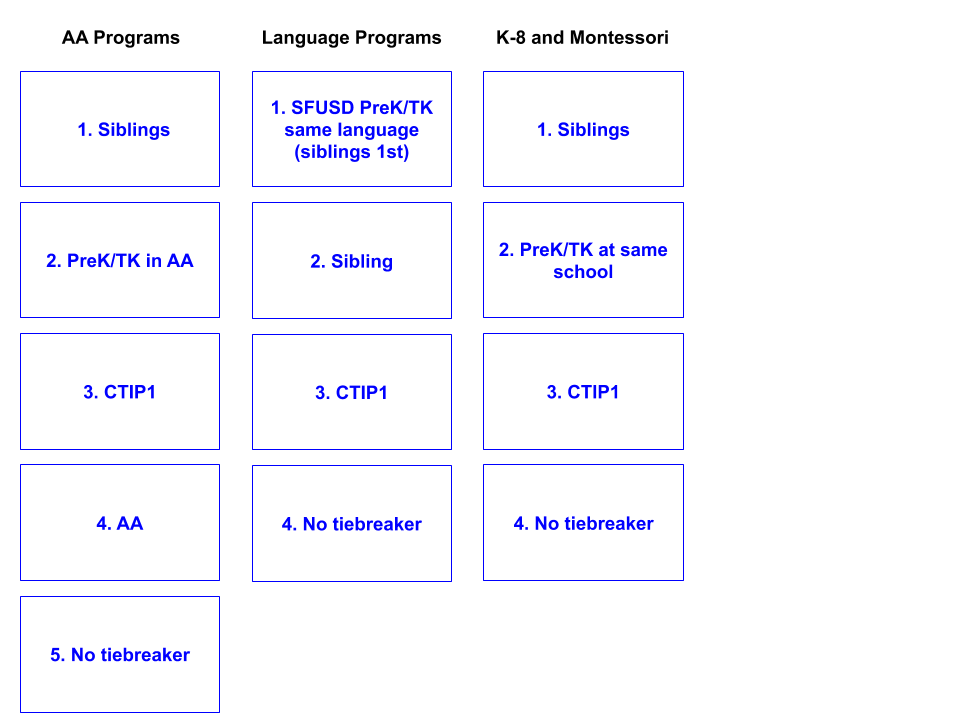SFUSD operates in a lottery system and is a bit complicated to understand. I’ll try to clarify it as simply as possible, and you also can watch this SFUSD video on how the lottery works. Some principles and vocabulary help to understand the assignment system.
Each school lottery runs independent of where you put it on your list. In other words, if you list a nearby school second because you like it but prefer a language program, you will not hurt your chances at the second-place school. The computer will run the lottery for each school on your list, and then you would be assigned the highest on the list.
Assignment Area is the school for your address and as close as SFUSD gets to a zoned school, except it’s a tie breaker with no guarantee. Look up your assignment area school and whether you are CTIP1
CTIP1 is a tiebreaker for the lowest decile census tract based on your home address, which is the district's proxy for diversity. Historically, the district used race, but due to a lawsuit, switched to CTIP1. Regardless of your race or socioeconomic status, CTIP1 is now a tiebreaker, and there is no specific tiebreaker for socioeconomic status.
Program Types. SFUSD elementary school programs are in three categories. A given site can have two programs, General Education and a Language Program, and you list each separately.
AA Schools are those with an assignment area (AA), where your address gives you a tiebreaker. Some AAs have a preK or TK in them, and children who attend that program *and* live in the AA get a high tiebreaker.
Language Programs offer a foreign language and are citywide. Dual Language Immersion (Cantonese, Korean, Mandarin, Spanish) typically mix ⅔ kids who pass a verbal language test with ⅓ kids who do not, except Alice Fung Yu, which is the reverse ratio. Biliteracy pathway is limited to children whose home language includes the language (Cantonese, Spanish) regardless of fluency. Foreign Language in Elementary School (Filipino, Japanese) offers daily instruction without immersion. Ten seats out of 44 kindergarten spots in each Japanese program are reserved for those who pass the verbal language test. All language programs have the Program Tiebreaker for children in SFUSD preK/TK for the same language.
K-8 Schools (non-language) are also citywide. Some K-8 schools have a preK or TK in them, and children who attend that program and live anywhere in SF get a tiebreaker.
Tiebreakers for SFUSD
Rounds of the Lottery
SFUSD Lottery currently runs in rounds, each with the same tiebreakers and rules described above. Look at Enrollment Key Dates for specific dates each year.
Round 1 is due in January, and parents hear by mail in March. You may list as many schools as you’d like in round 1. You must register at the assigned school to keep the assignment.
Round 2 is due in April each year, and parents hear by mail in May. You may list as many schools as you’d like in round 2, ideally any school you prefer more than your round 1 assignment. You must register at the assignment school to keep the assignment.
Round 3 or June Waitpool is due around the end of May each year, and parents hear by mail in June. You may only list one school in round 3.
Round 4 or August Waitpool is due in August each year, and parents hear by the end of the second week of school. You may only list one school in round 4.
Open Enrollment for SFUSD starts the end of June, and you may register for any school without a wait pool.
Resources
Need more help?
Vicky consults with families to help select public and private schools in San Francisco. Email to learn more about her services.


Comments